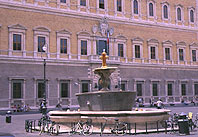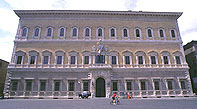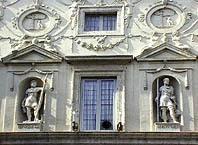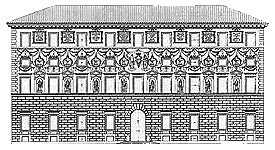A Walkabout Renaissance
Palazzo Farnese
 Most people consider this the ultimate Renaissance palace: big, beautiful and brimming with art.
Most people consider this the ultimate Renaissance palace: big, beautiful and brimming with art.
Michelangelo (1475-1564) was the key architect here, responsible for the overhanging Florentine roof and the wide cornice just below it, as well as the exuberant central loggia window over the entrance.
![]() Our favorite: look up at this window at night when the light is still burning here in the French Ambassador's beautiful office and you will see the glorious ceiling painting.
Our favorite: look up at this window at night when the light is still burning here in the French Ambassador's beautiful office and you will see the glorious ceiling painting.
 During the two decades Michelangelo directed this gigantic building project, he created the top floor, with taller-looking windows and higher ceilings than his predecessor, Sangallo, had used in the lower two floors.
During the two decades Michelangelo directed this gigantic building project, he created the top floor, with taller-looking windows and higher ceilings than his predecessor, Sangallo, had used in the lower two floors.
So the inventor of Mannerism, inverted the usual ratio, whereby upper floors are given less importance than the lower ones. The added height saved the endlessly long facade from seeming as monotonous as the front of the nearby Cancelleria.
The Mannerist conception he shared with Raphael was of breaking the classical rules of architecture to introduce tension, a disturbing note, into the building.
Since the French Ambassador lives and works here, you cannot enter without an invitation. This denies you a view of the monumental inner courtyard, and the state dining room whose frescoes by Annibale Carraci (1560-1609) portray the sort of mythical love-play among pagan gods that you would expect to find in a French boudoir.
Looking at the palace from the sumptuous square in front, you would never imagine that to the left of the Ambassador's office is one enormous room - so gargantuan that it rises two stories to include not only the six windows next to the Ambassador's, but also all six windows above! Such Mannerist distortions foreshadowed Rome's Baroque.
In the square, the two fountain basins match the palace's scale. Brought here from the Baths of Caracalla, they remind us that giganticism was one of the things being revived by the Renaissance.
| Palazzo Farnese History 1514. Alexander Farnese, a high flying Cardinal with the full panoply of mistresses, bastards and well-endowed nephews and grandchildren ordered an "adequate lodging" from Antonio de Sangallo, the Younger, fashionable architect of the new style. Farnese had been made Cardinal in 1493 when he turned 25, thanks to his sister who was Pope Alexander VI Borgia 's official mistress. 1534. Farnese became Pope Paul III and ordered the palace aggressively enlarged, as a show place for his rich and famous family. He greeted Michelangelo's return to Rome with "I've been looking forward to employing you for thirty years" and commissioned him to do, first the Last Judgment in the Sistine Chapel, and finally the family palace. Neither of these septuagenarians was to see the palace completed. Michelangelo also designed a private bridge so that the Farneses could stroll across the Tiber to the family's Villa Farnesina without mixing with the "hoi poloi", but only the gracious span across Via Giulia was ever constructed; don't miss it. 1564. Michelangelo died and Giacomo della Porta added the rear facade over the garden, with its high loggia to view St. Peter's. |
 Don't miss the sculpted facades of this building, both inside and out. Most of the surface is covered with decorative or representational carvings, going a step further than earlier buildings whose outer walls were adorned with paintings or mosaics. Best of all is the false perspective gallery.
Don't miss the sculpted facades of this building, both inside and out. Most of the surface is covered with decorative or representational carvings, going a step further than earlier buildings whose outer walls were adorned with paintings or mosaics. Best of all is the false perspective gallery.
You can duck into the courtyard at virtually any hour, and if there is enough light you can see the glories of this palazzo, that marks the transition from Renaissance to Baroque.
It is hard to believe it was designed only a few years after Palazzo Farnese was started. If Farnese is partly Mannerist, Spada is the epitome of Mannerism, this slightly wicked style reacting against the austerity of early Renaissance classicism.
The stuccoes on the facade include statues of famous antique personalities; above these are garlands and medallions, as well as inscriptions relating to the figures below.
In the courtyard, the decor is even more frivolous: cavorting centaurs and tritons, as well as festoons of flowers and fruit. But the high point of superfluity is the famous "trompe l'oeil" gallery by Borromini, who was almost never frivolous. Through the glass wall of the library and on the other side of a small formal garden is what appears to be a long colonnade leading to a life-size statue.
But closer examination (and a tip to the guard should permit you to step into that garden and see for yourself) shows you that the corridor is about a quarter as long as it looks, and that the statue is tiny. Borromini reduced all the dimensions of this colonnade in careful proportion as it recedes, centimeter-by-centimeter, from the eye of the spectator - with the result that a person standing next to the statue would seem a giant.
When you visit the Vatican and see the monumental Scala Regia staircase with its gradually foreshortened columns, you can decide if Bernini copied it from Borromini's Palazzo Spada.
| Palazzo Spada History  1549. Designed by Giulio Merisi da Caravaggio for Cardinal Capo di Ferro. 1556-1560. Giulio Mazzoni decorated the facades with stucco work. 17C. Cardinal Spada bought the palazzo and had it spruced up by his great friend Borromini, who designed the garden wall and added the "trompe l'oeil" gallery. 21C. Now the seat of the Italian Council of State. |
La Galleria Spada
The Galleria Spada, up the steps at the rear of the palazzo, contains 4 delightful rooms which house the family collection, including paintings by Breughel, Andrea del Sarto and Titian.
With permission from the Council of State (phone 06 68271 and ask for the head of Personnel), you can visit the salons of the palazzo, as well as corridors full of delightful stuccoes and the magnificent throne room where Popes were received royally when they dropped in for an evening's revelry.
In the adjoining corridor the lascivious scenes depicted on the ceiling would normally be X-rated and banned by the Church.
This palazzo gives you a feeling of those exciting times when cardinals whirled around the dance floors, beautiful women flirted with the monsignors and everybody tried to forget about the 1527 Sack of Rome and the threat of Protestantism.
The fountain in the small piazza in front of the palace has a nude female form with water spouting from her ample bosoms.
Open Tuesday - Saturday 9 am - 7 pm, Sunday open 9 am - 1 pm. Closed Monday